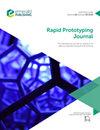Understanding the consolidation mechanism of selective laser sintering/powder bed selective laser process of ceramics: Hydroxyapatite case
IF 3.4
4区 工程技术
Q1 ENGINEERING, MECHANICAL
引用次数: 0
Abstract
Purpose The consolidation process and morphology evolution in ceramics-based additive manufacturing (AM) are still not well-understood. As a way to better understand the ceramic selective laser sintering (SLS), a dynamic three-dimensional computational model was developed to forecast thermal behavior of hydroxyapatite (HA) bioceramic. Design/methodology/approach AM has revolutionized automotive, biomedical and aerospace industries, among many others. AM provides design and geometric freedom, rapid product customization and manufacturing flexibility through its layer-by-layer technique. However, a very limited number of materials are printable because of rapid melting and solidification hysteresis. Melting-solidification dynamics in powder bed fusion are usually correlated with welding, often ignoring the intrinsic properties of the laser irradiation; unsurprisingly, the printable materials are mostly the well-known weldable materials. Findings The consolidation mechanism of HA was identified during its processing in a ceramic SLS device, then the effect of the laser energy density was studied to see how it affects the processing window. Premature sintering and sintering regimes were revealed and elaborated in detail. The full consolidation beyond sintering was also revealed along with its interaction to baseplate. Originality/value These findings provide important insight into the consolidation mechanism of HA ceramics, which will be the cornerstone for extending the range of materials in laser powder bed fusion of ceramics.了解陶瓷选择性激光烧结/粉末床选择性激光工艺的固结机理:羟基磷灰石案例
目的 基于陶瓷的增材制造(AM)中的固结过程和形态演变尚未得到很好的理解。为了更好地理解陶瓷选择性激光烧结(SLS),我们开发了一个动态三维计算模型,用于预测羟基磷灰石(HA)生物陶瓷的热行为。AM 通过逐层技术提供了设计和几何自由度、快速产品定制和制造灵活性。然而,由于快速熔化和凝固滞后,可打印的材料非常有限。粉末床熔融中的熔融-凝固动力学通常与焊接相关,往往忽略了激光辐照的固有特性;毫不奇怪,可打印材料大多是众所周知的可焊接材料。研究结果确定了 HA 在陶瓷 SLS 设备中加工时的凝固机制,然后研究了激光能量密度的影响,以了解它如何影响加工窗口。研究揭示并详细阐述了过早烧结和烧结机制。这些发现为了解 HA 陶瓷的固结机理提供了重要依据,将为扩大激光粉末床陶瓷熔融的材料范围奠定基础。
本文章由计算机程序翻译,如有差异,请以英文原文为准。
求助全文
约1分钟内获得全文
求助全文
来源期刊

Rapid Prototyping Journal
工程技术-材料科学:综合
CiteScore
8.30
自引率
10.30%
发文量
137
审稿时长
4.6 months
期刊介绍:
Rapid Prototyping Journal concentrates on development in a manufacturing environment but covers applications in other areas, such as medicine and construction. All papers published in this field are scattered over a wide range of international publications, none of which actually specializes in this particular discipline, this journal is a vital resource for anyone involved in additive manufacturing. It draws together important refereed papers on all aspects of AM from distinguished sources all over the world, to give a truly international perspective on this dynamic and exciting area.
-Benchmarking – certification and qualification in AM-
Mass customisation in AM-
Design for AM-
Materials aspects-
Reviews of processes/applications-
CAD and other software aspects-
Enhancement of existing processes-
Integration with design process-
Management implications-
New AM processes-
Novel applications of AM parts-
AM for tooling-
Medical applications-
Reverse engineering in relation to AM-
Additive & Subtractive hybrid manufacturing-
Industrialisation
文献相关原料
| 公司名称 | 产品信息 | 采购帮参考价格 |
|---|
 求助内容:
求助内容: 应助结果提醒方式:
应助结果提醒方式:


